Huge thank you to our parents and family members who took the time to visit our ECC for our World of Work Week. We loved learning lots about all your different jobs. Please click the link to see all the fun we had.
Huge thank you to our parents and family members who took the time to visit our ECC for our World of Work Week. We loved learning lots about all your different jobs. Please click the link to see all the fun we had.
Please click the link to see our STEM workshop.
As part of our World of Work Week we are looking for any parents or family members that would be able to visit our ECC to share with the children information about their job. This will help support us to develop the children’s knowledge and understanding about the wide range of jobs available to them when they grow up. It helps create the foundations of our future work force.
The kind of information we are looking for is:
Please feel free to bring pictures, equipment, uniforms or props to help show the children more about your job.
The dates to visit would be 29th, 30th of May and 3rd of June. If you are able to help us with this task please speak to Sherrie to arrange a time for you to visit.
If anyone is unable to visit in person please feel free to create a short video sharing information about your job. Please email these to easherrie.devlin@glow.sch.uk
This week our activity is to use digital technology to research information.
You can choose anything to research and find out information or facts about. It could be about an animal, a place in the world, a food, a superhero or anything you wish.
Encourage your child to select the apps, support them to try typing in words, allow them to select the web page, use the mouse and look at the pictures. You could also try using voice recognition, such as Siri, to tell the device what they want to find out.
Then create a picture of what you have researched. Adults or children can write or type any information the children can recall from searching the internet about their chosen subject.
You can use pen and paper or even the drawing pad or app on computers/iPads to try and create your picture/poster.
You can bring your pictures into the ECC or, if you have created them on the computer, then email them to easherrie.devlin@glow.sch.uk
Have fun.
In the next few weeks we will be starting to develop the children’s learning through exploring different types of jobs that are available in the world we live in.
Therefore, for this home link activity I thought it would be fun to get all our family members to think back to when they were young(er) and what they dreamt of being when they grew up.
So the task is to create a short video discussing what job you wanted to have.
Please encourage the children to use an iPad, phone or recording device to select the app to video your discussion, allow them to watch and help attach the video and send the email.
Discuss what roles the job might have, if the job uses specific tools, the uniform they might wear, the products they produce, where in the world they might work, who they might help, why you wanted to have this job and any other fun facts.
Please feel free to use props, pictures or even dress up to show us the jobs you wanted when you were young.
Please email any videos to easherrie.devlin@glow.sch.uk by Monday 6th of May.
Don’t worry – it will only be the kids and staff that will see the videos 😁
Please have a look at the attached sway to see how well our parental workshop went and the fabulous learning and foods that we created together. Don’t worry if you couldn’t get along to this one, please look out for further information about upcoming workshops.
|
This week the STEM challenge is to try and build the strongest bridge. Bridges come in all different shapes and sizes. They are also built with lots of different types of materials. I have attached a short video about bridges and some materials they can be made of.
The material that the bridge is made of can sometimes determine how strong the bridge is. Let’s experiment and build our own bridges out of different materials that we can find in our homes and test how strong they are.
You can use a range of different materials such as tinfoil, paper, cardboard or anything you find around your house that you think would make a good bridge. Encourage your child to feel, bend and explore the quality of the materials they choose. Encourage descriptive language such as strong, weak, long, short, hard or soft. Ask your child to try and predict which material they think will be the strongest before testing your bridges.
Here is an idea of how to create your bridge however I’m sure you will all have other fantastic ideas that I can’t wait to see.
Use two objects to create a balance point each side for your bridge.
Attach your material to create your bridges.
Place a few of the same item on each bridge and continue to place them on until your bridge cannot hold anymore. Count how many each bridge can hold before collapsing.
What you will need:
Two thick books or small boxes
Paper, cardboard or tinfoil
Tape
Coins or other small, heavy objects to use as weights (small rocks, nuts and bolts, etc.)
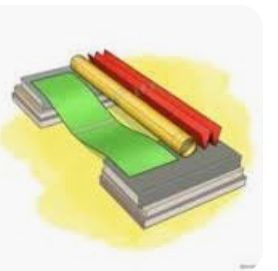
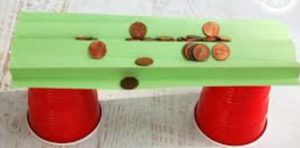
You could get your child to record how many of the different items each bridge could hold. A tally mark chart is a good way to record information and to compare which material was the strongest.
Hope you have fun and please upload any photos to your child’s learning journal or email them to easherrie.devlin@glow.sch.uk
Since we are finishing up for our holiday I thought I would make this STEM homelink out of this world!
I will provide different activities that link with the meaning of STEM. These activities will be based on developing the children’s knowledge of space.
S stands for Science.
Here are some videos to help explain what space is and facts about our planets.
https://m.youtube.com/watch?v=qfnceI0H-yc
https://m.youtube.com/watch?v=w36yxLgwUOc&cbrd=1
Here is a link to a fun rocket launch experiment if you would like to give it a try.
https://www.123homeschool4me.com/soda-rocket-science-experiment-for-kids_49/
T is for technology.
For this activity encourage your child to independently use an iPad, laptop or phone to search some facts about space, rockets, astronauts or planets.
Siri is great to use to support your child to search facts without typing or you can guide them as to what letters they need to type to search.
Once your child has found some facts they could make a short video or poster to share with us some of the interesting information they have found.
E is for engineering.
The children have recently been enjoying the junk modelling in the ECC so have a look around the house and see if there are any materials you can use to create your own solar system or rocket. Here are a few ideas:
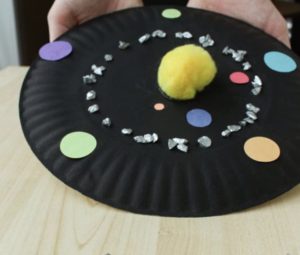
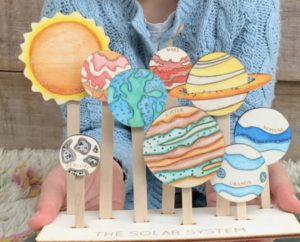
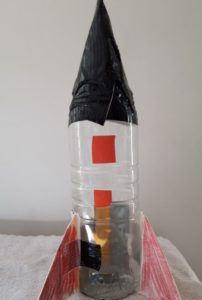
M is for maths.
If we have a clear sky on a few nights during the holiday, have a look to see if you can see any stars in the sky. Encourage your child to try and count how many stars they can see in the sky that night. Encourage your child to mark make (tally mark) or write the number to record how many stars they see each night.
Please send any pictures or videos to easherrie.devlin@glow.sch.uk
or upload them to your child’s learning journals.
I can’t wait to see them!
Have a wonderful break!
This is the beginning of our STEM homelink block where we will be providing the children with fun activities to promote STEM based learning at home. We will post a different activity each week for a 4 week block.
For our first activity we will experiment with some resources to try and create a secret message or picture by creating invisible ink.
What you will need: a lemon, a bowl, paper, a cotton bud and a light bulb or a crayon.
Here is how to make our invisible ink:
Squeeze the lemon juice into a bowl. Mix gently. Dip the cotton bud into the liquid and write a message or draw a picture on the paper.
Let the liquid dry completely so that the message or picture is invisible.
To share your secret or to see your picture hold it close to a lightbulb with an adult’s help. The message will be revealed.
If you don’t want to use a heat source then can also sprinkle salt over you paper when the lemon juice is drying. Then brush the excess salt off when the paper is dry and use a crayon to colour over your work to reveal the secrete.
Encourage your child to try and predict what will happen when their paper is held up to the light bulb or when you colour the paper with a crayon.
The lemon juice will change colour when it is exposed to a slight heat. This is a chemical reaction.
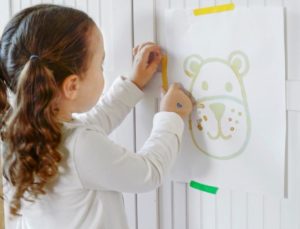
Please share any of your invisible ink messages or pictures with me. You can send a photo of your work to easherrie.devlin@glow.sch.uk
You can also upload a photo to your learning journal or bring in your invisible ink work and we can look at it in the ECC.
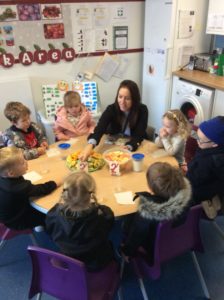
The children enjoyed looking at the different types of seeds that came from some of the fruit they were offered at snack. During snack, the staff ensure they are at the children’s level to communicate effectively. They ensure they have eye contact and give the children their full attention during discussion. They also allow the children adequate time to respond, promoting and encouraging positive interactions. The children used descriptive language to describe the texture, shape and size of the seeds. When participating in the discussion they communicated their thoughts and knowledge effectively. They discussed where the seed came from, what seeds require to help them grow and what they might grow into.